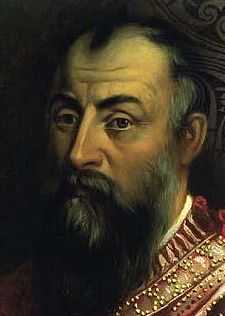Sir William Warren (died 1602)
Sir William Warren (c.1558-1602) was an Irish landowner, statesman and soldier of the late sixteenth century. He is mainly remembered now for having arranged the marriage of Hugh O'Neill, Earl of Tyrone and Mabel Bagenal.
Family
He was the son of Captain Humphrey Warren (died 1561) and Elizabeth Clifford (died 1581). His father, a professional soldier, had come to Ireland in the service of the English Crown about 1550 and retained the confidence of three successive monarchs. He was a close associate of Thomas Radclyffe, 3rd Earl of Sussex, Lord Deputy of Ireland 1556-1558, and he sat in the Irish House of Commons as member for Carrickfergus in the Parliament of 1559. His marriage was a most advantageous one since Elizabeth, daughter of a Kentish gentleman, Nicholas Clifford of Holme, was the widow of Sir William Brabazon, the Vice-Treasurer of Ireland, and of Christopher Blount, a cousin of Baron Mountjoy. After Humphrey's death she made a fourth marriage to Sir John Moore. William was thus born into the heart of the Anglo-Irish nobility: he was a half-brother of Edward Brabazon, 1st Baron Ardee, and of Garett, 1st Viscount Moore.
William and his full brother Henry continued the pattern of advantageous marriages: Henry married Alice Loftus, daughter of Adam Loftus, Archbishop of Dublin, and William, sometime after 1586, married Jenet Finglas, widow of John Bathe, Chancellor of the Irish Exchequer. Through this marriage he acquired for his lifetime possession of very substantial lands in County Dublin, and of Drumcondra Castle.
His wife's open adherence to the Roman Catholic faith caused him some trouble politically : at a time when Irish office holders were required to take the Oath of Supremacy, recognising Elizabeth I as head of the Church of Ireland, Warren was suspected, probably with good reason, of sharing his wife's beliefs. Of her first husband's children, two became Catholic priests, which inevitably raised questions about the nature of the religious upbringing they had received at home.
William Warren and Hugh O'Neill
He was given a military command, and in April 1586 he was entrusted by the Lord Deputy of Ireland, Sir John Perrot, with the task of negotiating with Sorley Boy MacDonnell, the powerful Scottish chieftain who had challenged the authority of the English Crown by establishing a political presence in County Antrim. Sorley is said to have been on friendly terms with William's father Humphrey in the late 1550s, and William succeeded in persuading him to make terms with the Crown. William asked repeatedly to be made Governor of Carrickfergus, but without success. Like his half brother Garrett, Lord Moore, he became a close friend and ally of Hugh O'Neill.
O'Neill and Mabel Bagenal
O'Neill's third marriage in August 1591 to Mabel, daughter of Sir Nicholas Bagenal, Knight Marshal of Ireland, is one of the most romanticised episodes in Irish history: Mabel has been called "the Helen of Troy of Elizabethan Ireland". Whether it was a genuine love marriage (as suggested in the play Making History by Brian Friel) or whether it was simply an effort by O'Neill to conciliate Mabel's powerful family is debatable. What is clear is the central role which Warren and his wife played in the marriage. Mabel, who had been living with her sister Mary, wife of Patrick Barnewall at Turvey House, arrived at Drumcondra Castle, about six miles away, where she was quickly followed by O'Neill. In the detailed version given by Sean O'Faolain, Warren himself visited Turvey House to pay a call on Mabel, and purported to "kidnap" her (with in fact her full connivance): they rode to Drumcondra, followed by O'Neill. Since Mabel wished for a Protestant ceremony, the marriage was celebrated in the Castle by Thomas Jones, Bishop of Meath, and future Archbishop of Dublin, although the Bishop, by his own account, acted with great reluctance, and only to save Mabel's good name. It was followed by five days of feasting, after which the newlyweds departed for O'Neill's home at Dungannon. Warren is said the have been a regular visitor to O'Neill's house in the following months, and to have accompanied him several times to Mass. These stories, whether true or false, can only have increased suspicions about his loyalty to the Crown.
Nine Years War
The outbreak of the Nine Years War, one of the most serious Irish rebellions against English rule, in which Hugh O'Neill was the overall commander on the Irish side, placed Warren in a very difficult position: despite his English parentage and powerful connections, his closeness to the "Arch-Rebel" O'Neill, and the suspicion that he was secretly a Roman Catholic, raised questions about his own loyalties, although he was prepared to fight against O'Neill, and also to persuade him to come to terms. By 1596 Warren's loyalty was so suspect that, despite being seriously ill, he was summoned to a meeting of the Irish Privy Council where he was reprimanded and threatened with imprisonment.
Later years
His fortunes improved during the Deputyship of Robert Devereux, 2nd Earl of Essex: Warren was in high favour with Essex, whom he entertained at Drumcondra Castle. After the downfall of Essex, Warren was quick to ingratiate himself with the rising power at the English Court, Robert Cecil, 1st Earl of Salisbury. Through Cecil's favour he at last obtained the Governorship of Carrickfergus, but died soon afterwards.
His marriage seems to have been childless, and at his death possession of his lands reverted to the Bathe family. Jenet remarried Terence O'Dempsey, 1st Viscount Clanmalier. She died in 1627.
Related sites
References
- Ball, F. Elrington History of the Parishes of Dublin 6 Volumes 1902-1920 Dublin Alexander Thom and Co.
- Calendar of State Papers for the reign of Elizabeth I 1586-1588 Vol. 123 April 1586
- Sean O'Faolain The Great O'Neill Mercier Press Cork 1942
.
